Back
Something quick and easy to grab on the go, protein bars can be a convenient option when we need something filling to tie us over to the next meal. Choosing the right options can be a great way to boost our daily nutrient intake and help us meet our protein requirements. It’s important to note that protein bars shouldn’t act as a meal replacement, they’re better as snacks or something we enjoy post-workout to top up our protein intake.
What makes it difficult to find a healthy protein bar in the supermarket?
With so many protein bars available, knowing which ones are living up to their claims can be hard. It’s not uncommon to see protein bars in the supermarket tailored to weight loss, making bold marketing claims, or limiting certain macronutrients (I’m looking at your ‘low carb’ protein bars).
Unfortunately, this is often at the expense of their nutritional profile. You see, many of the nutritious (real food) ingredients are more nutrient dense. This also makes them energy-dense (aka higher in calories). When companies focus on making their products low-calorie to appeal to weight loss, it’s usually at the expense of the nutrients inside. Unfortunately, the lower calorie (and less nutrient-dense) foods generally leave us feeling unsatisfied and requiring more food later. Therefore, even if weight loss is our goal, we’re better off eating the nutritious option, feeling satisfied and not needing to overeat afterwards.
Along with this, companies may choose to cut costs by using cheaper, more refined ingredients, which also compromises the nutritional profile of the end product.
Qualities of a healthy protein bar:
Since protein is the star ingredient of a protein bar, one of the qualities we like to see is that they’ve used a quality source of protein. Whether it’s a good protein powder or ingredients like nuts and seeds, we want the protein to be coming from real food that preferably hasn’t gone through large amounts of processing.
Healthy protein bars should be naturally sweetened and have low sugar content. It’s even better when the sweetness comes from a whole food source (for example, dates) instead of added sugars. This is because added sugars are more refined and therefore broken down quicker. Compared to naturally sweet whole foods, which are bound to fibre and other beneficial nutrients or compounds.
Along with being a good source of protein, we like it when protein bars are nutritionally balanced. This involves them having sources of healthy fats and complex carbohydrates along with the protein that they contain. When snacks are nutritionally balanced, it helps to keep us fuller for longer and assists us in meeting our daily nutrient requirements.
Ingredients we like to see in a healthy protein bar:
Some particular types of real foods that we like to see in healthy protein bars are nuts and/or seeds. This is because they’re naturally good sources of protein, while also containing healthy fats and dietary fibre. Each one comes with its benefits and properties.
What are the healthiest protein bars available?
When it comes to healthy protein bars, more and more options are becoming available and that’s what we love to see! Here are some that are on our radar:
Amazonia Raw Protein Bar Creamy Vanilla Fudge
Ingredients: Protein & Fibre Blend (Soluble Fibre (Tapioca), Fermented Rice Protein, Sprouted Pea Protein), Brown Rice Syrup, Cocoa Butter, Puffed Amaranth, Coconut, Natural Flavour, Emulsifier (Sunflower Lecithin), Sea Salt, Antioxidant (Vitamin E), Sweetener (Steviol Glycosides).

Amazonia Raw Protein Bar Peanut Butter Choc Melt
Ingredients: Protein and Fibre Blend (Soluble Fibre (Tapioca), Peanuts, Rice Protein, Pea Protein Isolate), Brown Rice Syrup, Cocoa Butter, Peanut Butter 5%, Dark Choc Drizzle 4.5%, Cocoa Powder, Natural Flavours, Emulsifier (Sunflower Lecithin), Sea Salt, Antioxidant (Vitamin E), Sweetener (Steviol Glycosides).

RXBAR Protein Bar Blueberry
Ingredients: Dates, Dried Egg Whites, Tree Nuts (Almonds, Cashews), Dried Blueberries (5.6%), Natural Flavours
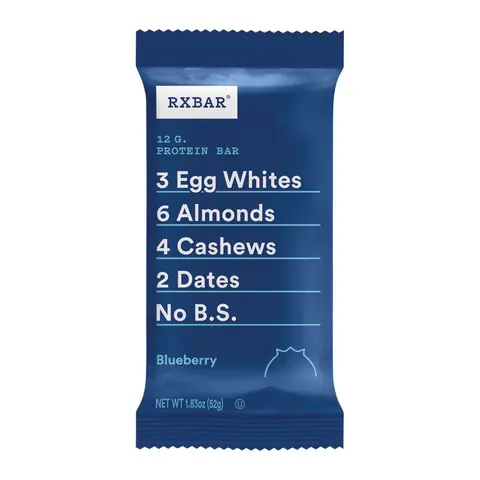
Review: By GoodnessMe Nutritionist Malissa Fedele
MINIMAL INGREDIENTS AND GOOD FOR YOUR BODY!
What I LOVE the most about these RXBAR Protein Bars in Blueberry flavour is how transparent they are with the ingredients. I love the packaging and how they clearly show what is in each bar and how much of each ingredient. As a nutritionist, I am always on the lookout for healthy treats and snacks that have been through very minimal processing and contain good-for-your-body ingredients that will provide you with a decent amount of energy that will last. These are the perfect post-gym snack as they are high in energy and will assist with getting your energy levels back to a good level! Also the perfect size for your gym bag!
Macro Mike Scrumptionator Protein Bar
Ingredients: Protein Blend (Almond Protein, Coconut Nectar, Coconut Milk Powder, Natural Flavours, Himalayan Rock Salt), Rice Malt Syrup, Date Paste, Shredded Coconut, Coconut Oil, Dairy Free Choc Chip (Cocoa Butter, Raw Sugar, Cocoa Mass, Cocoa Powder).
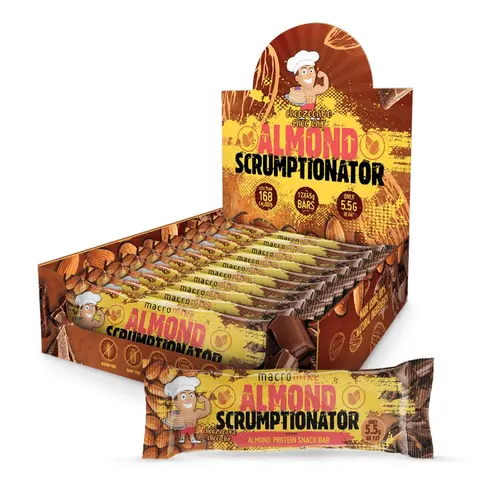
Review: By GoodnessMe Nutritionist Malissa Fedele
PROTEIN-PACKED VEGAN BAR
If you are after a tasty vegan bar, that packs a punch for protein and will supercharge your energy levels then you need to try these Macro Mike Almond Scrumptionator Protein Bar. Formulated with a delicious almond base, a blend of vegan proteins, natural sweeteners and coconut products, these bars do not lack any flavour.
These all-natural protein bars are also vegan, gluten, and dairy free and there are no peanuts in sight. However, I do only suggest that this is an occasional additive to your diet a couple of times a week as the sugar and KJ content is still relatively high.
Veego Chocolate Plant Protein Bars
Ingredients: Almond Butter, Organic Rice Malt, Date Paste, Organic Pea Protein, Organic Cacao Butter, Cashews, Organic Rice Protein, Cacao Powder, Vanilla Powder, Cinnamon
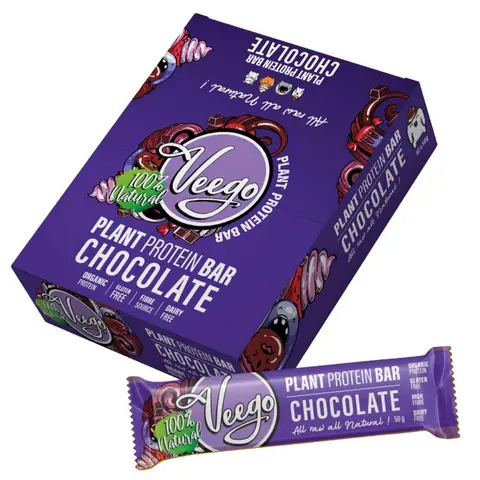
Kuranda Wholefoods Gluten Free Protein Bars Banana Split
Ingredients: Dates, Almonds, Coconut, Pea Protein, Soluble Fibre Tapioca, Apricots, Bananas, Pepitas, Chia Seeds, Cinnamon, Rice, Syrup, Coconut Syrup, Coconut Oil, Maple Syrup, Himalayan Salt, MCT Oil, Vit. E.
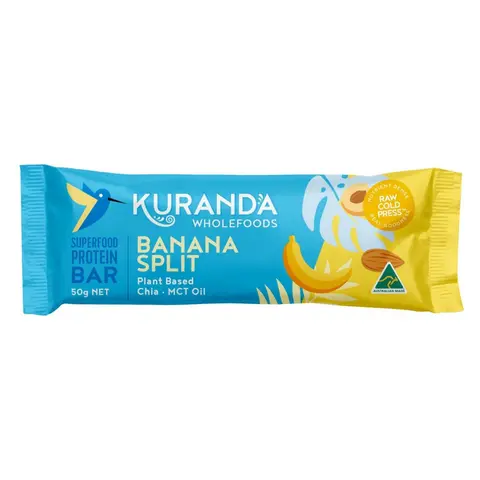
Review: By GoodnessMe Nutritionist Malissa Fedele
HIGH PROTEIN AND ALL-NATURAL
The Kuranda Wholefoods Gluten Free Protein Bars Banana Split make for a great on-the-go snack that you can keep handy in your bag for that quick energy replenishment. Made with just wholesome ingredients they are free from any nasty additives, colours and preservatives making them a low-processed option.
They are gluten-free, vegan, do not contain any added refined sugars, high in protein, a good source of fibre, low in carbs and a good all-natural alternative. A good option to have 1-2x per week when you are feeling like a quick energy boost.
Botanika Blends Vegan Protein Bar Blueberry Pancake
Ingredients: Cashew, Organic Pea Protein Isolate, Liquid Chicory Fibre, Coconut Oil, Dried Blueberries (7.5%), Natural Flavour, Beetroot Powder, Organic Brown Rice Protein Isolate, Blueberry Juice Powder (1.5%), Coconut Milk Powder, Inulin, Acacia Fibre, Natural Marine Minerals (Calcium, Magnesium), L-Glutamine, BCAAs (Leucine, Isoleucine, Valine, Emulsifier (Sunflower Lecithin)), Guar Gum, Natural Sweetener (Stevia), Probiotic Culture (Bacillus Coagulans), Digestive Enzymes (Protease, Amylase, Cellulase, Lactase, Lipase).
Review: By Nutritionist Shelley M.
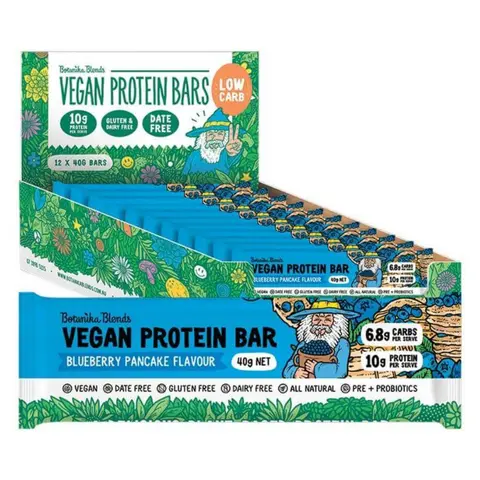
NUTRIENT-DENSE SNACK
These Vegan Protein Bars are a nutrient-dense snack to have on the run. They offer good fats and protein, as the main macronutrients. Plus have a range of vitamins and minerals thanks to berries, beetroot and marine minerals. Inulin and Acacia offer gut fibre. While the Probiotic Culture (Bacillus Coagulans), Digestive Enzymes (Protease, Amylase, Cellulase, Lactase, and Lipase) support the guts pre and probiotic balance. These low-sugar, keto-loving bars are a great alternative when you need something on the go. Throw them in your handbag or keep them at your desk for when the munchies set in.
Mt Elephant Rise Apricot & Nut Hemp Bar
Ingredients: Nuts 29% (peanuts, almonds), brown rice syrup, apricots 12% (apricots, rice flour), hemp seeds 11%, brown rice crisps (rice flour, rice bran), sunflower seeds, pepitas 4.5%, chia seeds 1.8%, currants, sunflower oil, natural flavour.

What to look for on the nutritional panel:
Let’s take a closer look at a healthy protein bar and what makes it a good option. For this example, we’re using the Kuranda Wholefoods Gluten Free Protein Bar, in the Cacao Nut flavour.
When examining any product, we shouldn’t just be looking at the marketing claims on the front. While they can be helpful to alert us to certain features of a product, they don’t give us the whole picture. Always turn the packaging around and look at the ingredients list and nutrition panel.
The nutrition panel of this Kuranda Wholefoods Bar shows us that there is 12g of protein per serve. We want to see at least 10g of protein in a serving when it comes to protein bars, so this bar meets that criterion. If a product shows less than 10g of protein per serving, it’s not necessarily a bad product, it just means it’s probably more of a snack bar than a ‘protein’ bar.
It’s great to see there are no trans fats at all in this product and this is another benchmark of a healthy protein bar. Trans fats are the most detrimental type of fat for our health, they can lead to heart problems and other cardiovascular conditions. We should avoid this type of fat whenever possible.
Another thing we can look at on the nutrition panel of a protein bar is the fibre content. The recommended daily intake of fibre for adults in Australia is 25g for women and 30g for men. The sad reality is that only 1 in 5 people meet this recommendation. Choosing a protein bar that has around 5g of dietary fibre is going to help boost our fibre intake and get us towards that daily target.
Lastly, we can take a look at the sugar content of a protein bar by looking at the value per 100g. This gives us a percentage value. With 24g of sugar per 100g, this particular protein bar is 24% sugar. Thankfully it’s coming from natural sources, which is something we can see by looking at the ingredients list.
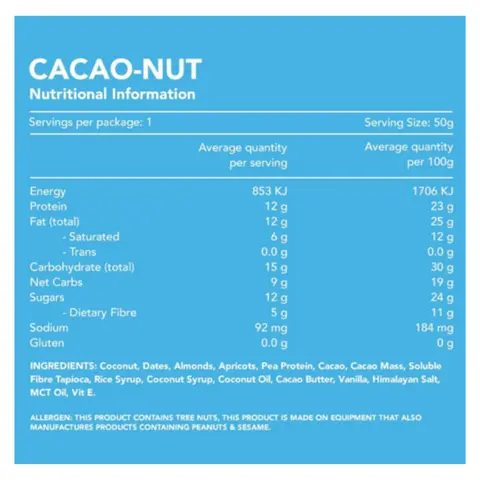
How to read the ingredient list on your protein bar:
More important than the nutrition panel (and something I recommend looking at first) is the ingredients list of a product. Is it made up of real foods? If yes, then we can proceed with looking at the values on the nutrition panel. If not, then it probably belongs back on the shelf.
The ingredients for the Kuranda Wholefoods Gluten Free Protein Bar, in the Cacao Nut flavour, are as follows: Coconut, Dates, Almonds, Apricots, Pea Protein, Cacao, Cacao Mass, Soluble Fibre Tapioca, Rice Syrup, Coconut Syrup, Coconut Oil, Vanilla, Himalayan Salt, MCT Oil, Vit. E.
Reading over this list, we can understand what each of these ingredients are because they’re real foods. There are no numbers in sight and none of these foods sound like they’ve been made in a lab or belong in a science project.
Ingredients appear in order of most to least on an ingredients list. This can help us assess the ratio between the ingredients in the product. For example, the higher up we see added sugars on the ingredients list, the higher the sugar content that product is likely to have.
How to spot hidden ingredients in protein bars:
The best way to spot hidden ingredients is to look at the ingredients list. There’s no hiding there and all of the ingredients have to be listed. However, be wary of umbrella terms like flavours, which don’t disclose what they’re made up of.
What are flavours and why should we avoid them in this product?
When we see the word ‘flavours’ on an ingredients list, this refers to artificial ingredients that make up a particular flavour profile. Remember that flavour itself isn’t a food, it’s a description of a particular taste. While just one word, flavours can hide many chemical ingredients under this umbrella term. Look for products that use real foods to achieve a certain flavour instead. For example, cacao powder in chocolate products, rather than ‘chocolate flavour’.
What does an unhealthy protein bar look like?
We’ve looked at several healthy protein bars and what to look for in a good quality product, but what about the flip side of that? Here we’ll take a look at a not-so-healthy option, the Aussie Bodies Lo Carb Protein Bar in the Crunchy Rocky Road flavour.
Looking at this product, we see a long list of ingredients, which in itself is a red flag. What’s more is that many of these ingredients are highly refined, artificial, or potentially inflammatory.
Among the first ingredients, we see soy protein isolate which may seem healthy but goes through extensive processing. To make this isolate, the soybeans have the hull and fat removed and are turned into flakes. These flakes are then washed with alcohol or acidic water to remove the sugars and dietary fibre, leaving a product that is predominantly protein.
Further down the ingredients list, we can see polydextrose, which is a synthetic ingredient used in place of sugar to sweeten this product. Like anything made in a lab, this doesn’t meet our real food criteria. Speaking of synthetic ingredients, artificial flavours are also present on this list.
Maltitol is another ingredient of concern on this list. While not a synthetic product, it has been highly processed and is what we call a ‘sugar alcohol’. Sugar alcohol can cause digestive discomfort in some people, so proceed with caution. Similarly, erythritol appears here and is also sugar alcohol.
Glycerol is another highly refined ingredient, this time in the form of an oil that has undergone hydrolysis, saponification or transesterification.
If all of this isn’t enough, it also contains vegetable fat. Made from hydrogenated vegetable oils, vegetable fat often contains trans fats. This ingredient can be inflammatory and doesn’t belong in healthy options.
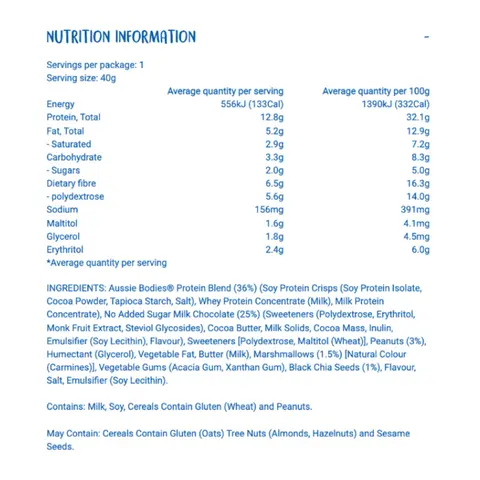
What else should you consider when choosing a healthy protein bar?
Taking into consideration everything we’ve learnt in this blog post, some good questions that we can ask ourselves when picking out a healthy protein bar include:
- Is the protein coming from a good quality, real food source?
- How has this product been sweetened?
- Is this a nutritionally balanced option?
Our top 3 protein bar products to avoid and why:
Body Science Collagen Low Carb Protein Bar Caramel Choc Chunk
Ingredients: No Added Sugar Milk Protein Chocolate (Sweetener [Maltitol], Cocoa Solids 33%, Milk Solids 20%, Soy Protein Isolate, Emulsifiers (Soy Lecithin, Polyglycerol Polyricinoleate), Natural Vanilla Flavour), Sweetener (Sorbitol), Polydextrose, Whey Protein Isolate, Tendoforte® Hydrolysed Collagen Peptides 8.5%, Caramel Paste 8% (Invert Sugar, Humectants [Sorbitol, Glycerol], Concentrated Pear Puree, Bulking Agent [Polydextrose], Sunflower Oil, Citrus Fibre, Natural Colours [Caramel I, Titanium Dioxide], Gelling Agent [Pectin], Firming Agent [Calcium Lactate], Natural Flavour), Calcium Caseinate, Humectant (Glycerol), Milk Protein Concentrate, Chocolate Chips 4%, Sugar-Free Caramel Chips 3%, Soy Protein Nuggets, Sunflower Oil, Natural Flavour, Emulsifier (Soy Lecithin), Salt, Antioxidant (Vitamin E), Sweetener (Steviol Glycosides)
Where to even begin on this one?! With over 30 ingredients listed on the label, there’s a whole lot of highly refined ingredients and not a lot of real food. There’s sunflower oil and glycerol, which can be inflammatory. We can see sugar alcohols maltitol and sorbitol. And then there’s polydextrose which is a synthetic ingredient. I could keep going but it’s easy to see why this product can’t be considered a healthy or real food option.

Musashi High Protein Bar Cookies & Cream

Ingredients: Musashi High Protein Blend (55%) [Hydrolysed Collagen Protein, Calcium Caseinate, Soy Protein Isolate, Whey Protein Isolate, Soy Protein Nuggets (Soy Protein Isolate, Cocoa Powder, Tapioca Starch), Emulsifier (471)], No Added Sugar Milk Chocolate (18%) [Maltitol, Cocoa Butter, Cocoa Mass, Milk Solids, Emulsifier (Soy Lecithin), Flavour], Glycerol, Water, Flavours, Sweetener (Sucralose), Emulsifier (Soy Lecithin).
This Musashi protein bar (and the others in the range) contain artificial flavours and an artificial sweetener (sucralose). As artificial ingredients are made in a lab, there’s nothing ‘real food’ about them. There’s also soy protein isolate which we’ve discussed earlier as being highly refined and treated. Plus, we can see the sugar alcohol maltitol on this ingredients list, along with several other highly refined ingredients.
Slim Secrets Mintabolism Boost Bar
Ingredients: Protein Blend [Soy Puffs (Soy Protein Isolate, Tapioca Starch, Salt), Soy Protein Concentrate, Soy Protein Isolate], Rice Syrup, Milk Compound Chocolate (21%) [Maltitol, Vegetable Fat, Soy Protein Isolate, Cocoa Powder (5%), Emulsifiers (Soy Lecithin, 476), Milk Solids (5%), Natural Flavour], Polydextrose, Vegetable Oil, Vegetable Glycerine, Flavours, Green Tea Extract (0.1 %), Salt, Soy Lecithin, Mint Oil (0.02%), Milk Compound Chocolate contains Cocoa Solids 5% and Milk Solids 5%
Despite having the clever name of metabolism, this bar isn’t going to do a lot for our metabolism. It contains both vegetable oil and vegetable fat, which are inflammatory ingredients. On the ingredients list, we can also see artificial flavours, plenty of highly refined soy protein and minimal real foods.
So, now we know exactly what to look for (and what to look out for) when choosing a healthy protein bar. Like with any healthy product, it is as simple as looking at the ingredients list and checking for real foods.
When in doubt, you can always make your protein bars at home. Simply add a good quality protein powder to a raw slice or incorporate plenty of nuts and seeds into the recipe. An unflavoured protein powder like the Bare Blends Bare Plant Protein is super versatile and perfect for this purpose. Give it a try by adding it to this Pineapple Coconut Slice.
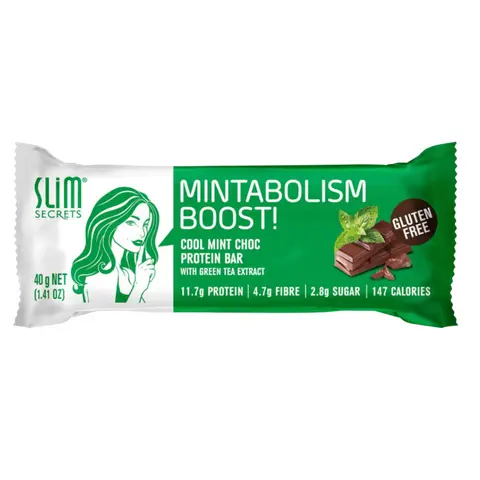
About the author- Shahna Sarpi is a qualified nutritionist that is on a mission to help people live a nourished life through real food and healthy habits. She loves simplifying food labels and helping people make healthier food choices. Shahna is passionate about spreading the real food message and supporting people in living a healthy life.

